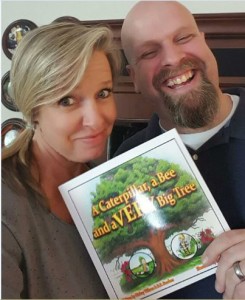 “A Caterpillar, a Bee and a Very Big Tree,” written by brother and sister pair, Dicksy Wilson and D. B. Sanders.
“A Caterpillar, a Bee and a Very Big Tree,” written by brother and sister pair, Dicksy Wilson and D. B. Sanders.
This rhyming picture book teaches cadence and rhythm and has a sing-song feel in places. The charming characters and illustrations will inspire young minds and immerse children in the action from the first page through the last. The main and recurring theme in the book is simple: “You can do anything if you put your mind to it.”
Throughout the tale, readers learn a few different important life lessons. Each of the following lessons can be used as a talking point for group discussion in the classroom or by parents as they read the book with their own child or children:
Lesson 1 – BE YOURSELF
In the earliest part of the story, a brief lesson in individuality comes from the main characters – a caterpillar named Gus who is a self-proclaimed procrastinator and not like the other “green fuzzies” and a bee named Shoo who is allergic to pollen and unable to work with the other “buzz-buzzies.” While they discuss the fact that they are different from their own respective kind, they decide that they can be friends with one another regardless of how they are viewed by others.
Discussion Tip:
After students have read or listened to the story, have them list the ways the main characters were unique. Have them next make a list of their own unique qualities. They can also list the unique qualities of their best friend and decide which (if any) qualities they share with their best friend.
Lesson 2 – HELP OTHERS
When the pair is faced with the conflict of the story – a huge storm coming straight for the mighty oak in which all of the other diligent caterpillars have already spun their cocoons – a lesson of helping others becomes the theme of the book. Gus and Shoo decide that they have to take a risk to save all of the others who may not have tied their cocoons tightly enough. They work together to overcome a multitude of obstacles in order to save the day, and, although they sometimes get a little panicked and overwhelmed with the task at hand, they always find a way to cooperatively solve the problems before them.
Discussion Tip:
Have students discuss all the obstacles the characters have to overcome, then have them tell about obstacles in their own lives that they’ve had to overcome.
Lesson 3 – THINK POSITIVE
Both characters deal with their own self-doubt along the way, but they rely on the gentle encouragement of each other and embrace a positive thinking approach. When Shoo doubts his ability to carry Gus to the top of the tree, Gus smiles at his friend, “I just know you can do it… you can do anything if you put your mind to it.” In the end, Shoo helps Gus overcome his fear of flying after he transforms into a beautiful butterfly.
Discussion Tip:
Have students discuss the techniques the characters used to think positively. Next, have them create or list some techniques they can use themselves to think positively in trying times.
Lesson 4 – NEVER GIVE UP
Throughout the book there are lessons about taking the time to slow down, think things through and never give up.
Teaching Tip:
Have students point out scenes in the book where the characters slow down to think things through and never give up. Have students talk about times in their own lives when they’ve felt like giving up. What kept them going?
MORE ON WRITING FOR CHILDREN
Writing a Fiction Story – Walking Through Walls Backstory
Writing Children’s Books – Genre Differences
How Do You Make a Good Story Worthy of Getting Past the Gatekeeper
Like this post? Please share it!
2 thoughts on “Talking about A Caterpillar, a Bee, and a VERY Big Tree in the Classroom”